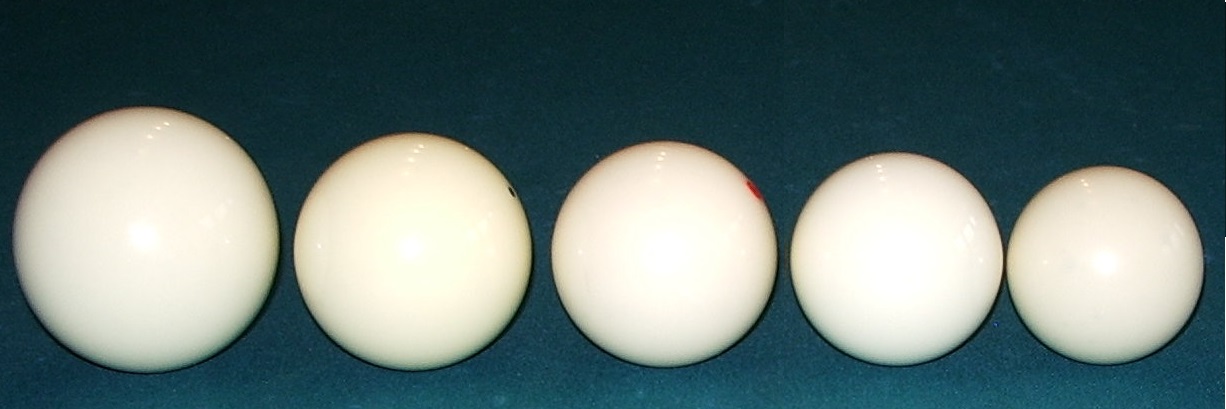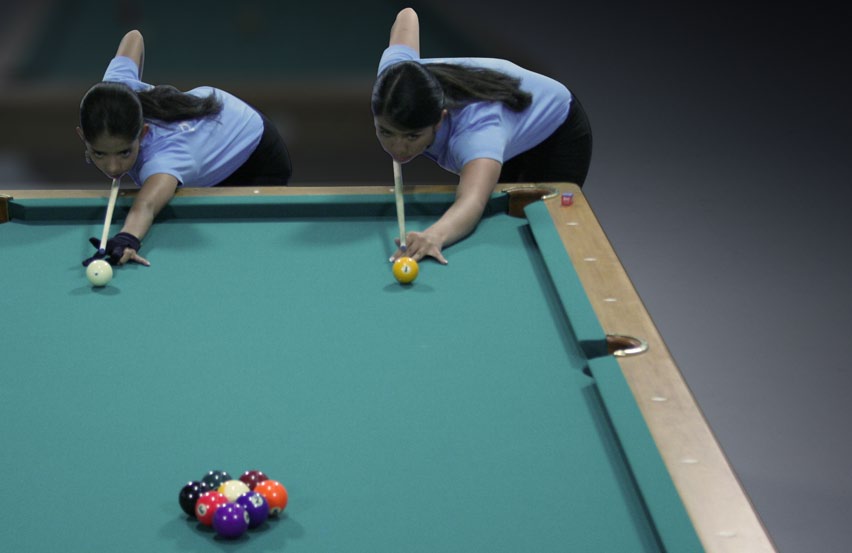|
English (cue Sports Term)
The following is a glossary of traditional English-language terms used in the three overarching cue sports disciplines: ''carom billiards'' referring to the various games played on a billiard table without ; ''Pool (cue sports), pool'', which denotes a host of games played on a table with six pockets; and ''snooker'', played on a large pocket table, and which has a sport culture unto itself distinct from pool. There are also games such as English billiards that include aspects of multiple disciplines. Definitions and language The term ' is sometimes used to refer to all of the cue sports, to a specific class of them, or to specific ones such as English billiards; this article uses the term in its most generic sense unless otherwise noted. The labels "British English, British" and "United Kingdom, UK" as applied to entries in this glossary refer to terms originating in the UK and also used in countries that were fairly recently part of the British Empire and/or are part of the ... [...More Info...] [...Related Items...] OR: [Wikipedia] [Google] [Baidu] |
Cue Sports
Cue sports are a wide variety of Game of skill, games of skill played with a cue stick, which is used to strike billiard balls and thereby cause them to move around a Baize, cloth-covered billiards table, table bounded by elastic bumpers known as . Cue sports, a category of List of stick sports, stick sports, may collectively be referred to as billiards, though this term has more specific connotations in some List of dialects of English, English dialects. There are three major subdivisions of games within cue sports: *Carom billiards, played on tables without , typically ten feet in length, including straight rail, balkline, one-cushion carom, three-cushion billiards, artistic billiards, and Four-ball billiards, four-ball *Pool (cue sports), Pocket billiards (or pool), played on six-pocket tables of seven, eight, nine, or ten-foot length, including among others eight-ball (the world's most widely played cue sport), nine-ball (the dominant professional game), ten-ball, straight ... [...More Info...] [...Related Items...] OR: [Wikipedia] [Google] [Baidu] |
Nine-ball
Nine-ball (sometimes written 9-ball) is a discipline of the cue sport pool. The game's origins are traceable to the 1920s in the United States. It is played on a rectangular billiard table with at each of the four corners and in the middle of each long side. Using a cue stick, players must strike the white cue ball to nine colored billiard balls, hitting them in ascending numerical order. An individual game (or ) is won by the player pocketing the . Matches are usually played as a to a set number of racks, with the player who reaches the set number winning the match. The game is currently governed by the World Pool-Billiard Association (WPA), with multiple regional tours. The most prestigious nine-ball tournaments are the WPA World Nine-ball Championship and the U.S. Open Nine-ball Championships. Notable 9-Ball players in the game include Luther Lassiter, Buddy Hall, Efren Reyes, Earl Strickland and Shane Van Boening. The game is often associated with hustling a ... [...More Info...] [...Related Items...] OR: [Wikipedia] [Google] [Baidu] |
8-Ball
Eight-ball (also spelled 8-ball or eightball, and sometimes called solids and stripes, spots and stripes, bigs and smalls, big ones and little ones, or rarely highs and lows) is a discipline of pool played on a billiard table with six pockets, cue sticks, and sixteen billiard balls (a and fifteen ). The object balls include seven solid-colored balls numbered 1 through 7, seven striped balls numbered 9 through 15, and the black 8 ball. After the balls are scattered with a shot, a player is assigned either the group of solid or striped balls once they have legally pocketed a ball from that group. The object of the game is to legally pocket the 8-ball in a "called" pocket, which can only be done after all of the balls from a player's assigned group have been cleared from the table. The game is the most frequently played discipline of pool, and is often thought of as synonymous with "pool". The game has numerous variations, mostly regional. It is the second most played profes ... [...More Info...] [...Related Items...] OR: [Wikipedia] [Google] [Baidu] |
Seven-ball
Seven-ball is a pool game with rules similar to nine-ball, though it differs in two key ways: the game uses only seven as implied by its name, and play is restricted to particular pockets of the table. William D. Clayton is credited with the game's invention in the early 1980s. Rules At the start of the game, balls one through seven are in a hexagonal configuration, with the 1-ball placed at the rack's , centered over the table's , the 7-ball placed at the rack's center, and all other balls placed clockwise ''(see photo top right)''. Immediately following the , the opponent must elect three pockets along one of the table's , and the player who broke is automatically assigned the three pockets situated along the opposite long rail. Once that selection is made, balls 1–6 may be in any pocket in rotation, starting with the one, as the object ball. Balls pocketed via combinations off of the object ball are legal. The 7-ball must be pocketed in player's assigned side to be a leg ... [...More Info...] [...Related Items...] OR: [Wikipedia] [Google] [Baidu] |
Nine-ball
Nine-ball (sometimes written 9-ball) is a discipline of the cue sport pool. The game's origins are traceable to the 1920s in the United States. It is played on a rectangular billiard table with at each of the four corners and in the middle of each long side. Using a cue stick, players must strike the white cue ball to nine colored billiard balls, hitting them in ascending numerical order. An individual game (or ) is won by the player pocketing the . Matches are usually played as a to a set number of racks, with the player who reaches the set number winning the match. The game is currently governed by the World Pool-Billiard Association (WPA), with multiple regional tours. The most prestigious nine-ball tournaments are the WPA World Nine-ball Championship and the U.S. Open Nine-ball Championships. Notable 9-Ball players in the game include Luther Lassiter, Buddy Hall, Efren Reyes, Earl Strickland and Shane Van Boening. The game is often associated with hustling a ... [...More Info...] [...Related Items...] OR: [Wikipedia] [Google] [Baidu] |
Danish Pin Billiards
Danish billiards or ''keglebillard'', sometimes called Danish five-pin billiards, is the traditional cue sport of Denmark Denmark is a Nordic countries, Nordic country in Northern Europe. It is the metropole and most populous constituent of the Kingdom of Denmark,, . also known as the Danish Realm, a constitutionally unitary state that includes the Autonomous a ..., and the game remains predominantly played in that country. It makes use of a 5 × 10 ft (approximately 1.5 × 3 m) six-pocket table, three billiard balls, and five (), which are considerably larger than those used in the similar and internationally standardized (originally Italian) game of five-pin billiards. Rules The aim of the game is to achieve a predetermined number of in as few shots as possible. The game is played with one red ball and two white balls. In an inversion of the normal play in most three-ball games such as carom billiards and English billiards, the red ... [...More Info...] [...Related Items...] OR: [Wikipedia] [Google] [Baidu] |
Five-pin Billiards
Five-pin billiards or simply five-pins or 5-pins (;''Sezione Stecca: Organigramma della Sezione - Attività agonistica - Calendari - Regolamento Tecnico Sportivo, 2004–2005'' , Federazione Italiana Biliardo Sportivo, 2004, Italy. ), is today usually a carom billiards form of cue sport, though sometimes still played on a table. In addition to the customary three balls of most carom games, it mak ... [...More Info...] [...Related Items...] OR: [Wikipedia] [Google] [Baidu] |
Four-ball Billiards
Four-ball billiards or four-ball carom (often abbreviated to simply four-ball, and sometimes spelled 4-ball or fourball) is a carom billiards game, played on a Billiard table#Carom billiards tables, pocketless table with four billiard balls, usually two red and two white, one of the latter with a spot to distinguish it (in some sets, one of the white balls is yellow instead of spotted). Each player is assigned one of the white (or yellow) balls as a . A is scored when a shooter's cue ball s on any two other balls in the same (with the opponent's cue ball serving as an , along with the reds, for the shooter). Two points are scored when the shooter caroms on each of the three object balls in a single shot. A carom on only one ball results in no points, and ends the shooter's . Asian variations A variant of four-ball is the East Asian game , or (四球, , Korean language, Korean for 'four balls'). The game is played with two red object balls, one white cue ball and one yellow cue ... [...More Info...] [...Related Items...] OR: [Wikipedia] [Google] [Baidu] |
Three-cushion Billiards
Three-cushion billiards, also called three-cushion carom, is a form of carom billiards. The object of the game is to the off both while contacting the at least three times before contacting the second object ball. A point is scored for each successful carom. In most shots the cue ball hits the object balls one time each, although hitting them any number of times is allowed as long as both are hit. The cue ball may contact the cushions before or after hitting the first object ball. It does not have to contact three different cushions as long as it has been in contact with any cushion at least three times in total. History Three-cushion dates to the 1870s, and while the origin of the game is not entirely known, it evolved from one-cushion billiards, which in turn developed from straight rail billiards for the same reason that balkline also arose from straight rail. Such new developments made the game more challenging, less repetitive, and more interesting for spectators as wel ... [...More Info...] [...Related Items...] OR: [Wikipedia] [Google] [Baidu] |
Three-ball
Three-ball (or "3-ball", colloquially) is a folk game of pool played with any three standard pool s and . The game is frequently gambled upon. The goal is to () the three object balls in as few shots as possible.PoolSharp's "Three-Ball Rules" The game involves a somewhat more significant amount of than either or , because of the disproportionate value of pocketing balls on the shot and increased difficulty of ... [...More Info...] [...Related Items...] OR: [Wikipedia] [Google] [Baidu] |
American Snooker
American snooker is a cue sport played almost exclusively in the United States, and strictly on a recreational, amateur basis. Diverging from the original game of snooker, rules for American snooker date back to at least 1925, and have been promulgated by the Billiard Congress of America (BCA) since the mid-20th century. The game is in decline, as the standardized international rules have largely supplanted it. American snooker has a simplified rule set compared to the international game, and is usually played on smaller tables. Depending upon equipment availability, the balls and may be larger than those for standard snooker, up to the size of pool balls and pockets. The United States Snooker Association is not connected with the game of American snooker, being the IBSF-recognized US governing body of standard-rules snooker. History American snooker made its first known in-print appearance in the 1925 edition of Brunswick–Balke–Collender Co.'s ''Rules Governing the R ... [...More Info...] [...Related Items...] OR: [Wikipedia] [Google] [Baidu] |






